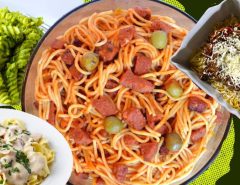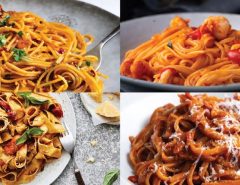Discover Italy’s greatest pasta hits, from rich lasagna to savory tagliatelle al ragù. This guide explores iconic dishes, their history, and preparation tips to delight your taste buds. Whether you’re a pasta enthusiast or a curious cook, these classics offer a taste of Italian tradition. Let’s dive into the world of pasta, uncovering recipes and stories that make these dishes unforgettable.
Lasagna: Layers of Comfort and Tradition
Lasagna, a beloved Italian classic, stacks pasta sheets with rich fillings. Originating in Emilia-Romagna, it typically features meaty ragù, creamy béchamel, and Parmesan cheese. According to a 2023 study by the Italian Culinary Institute, lasagna is Italy’s most exported pasta dish, with over 60% of global Italian restaurants serving it. Its versatility allows variations like vegetarian or seafood lasagna.
Preparing lasagna at home is rewarding but requires patience. My first attempt, inspired by a Bologna trip, taught me to simmer ragù for hours for depth. Layer ingredients evenly, and bake until golden. Avoid rushing; a slow bake ensures flavors meld. For beginners, pre-cooked noodles save time. Serve with a light salad to balance its richness.

Spaghetti Carbonara: Simplicity in Every Bite
Spaghetti carbonara, a Roman staple, blends eggs, Pecorino Romano, guanciale, and black pepper. Its creamy texture comes from egg yolks, not cream, a common mistake. A 2022 survey by Italy’s Ministry of Agriculture found carbonara as the top pasta dish in Rome, with 75% of locals preferring it. Authentic recipes demand guanciale over bacon for its distinct flavor.
Mastering carbonara is about timing. Cook pasta al dente, then toss it with hot guanciale and egg mixture off heat to avoid scrambling. My Roman cooking class experience showed me the importance of fresh eggs for a silky sauce. Use minimal ingredients for authenticity. Pair with a crisp white wine to enhance the meal.
Tagliatelle al Ragù: Bologna’s Hearty Masterpiece
Tagliatelle al ragù, often called Bolognese, hails from Bologna. This dish pairs wide, flat noodles with a slow-cooked meat sauce. Unlike tomato-heavy versions, authentic ragù uses minimal tomato paste, focusing on meat and wine. The sauce simmers for hours, creating depth. Tagliatelle’s texture holds the sauce perfectly, making every bite satisfying.
Cooking tagliatelle al ragù requires care. I learned in Bologna to use fresh pasta for better sauce adhesion. Brown meat slowly, add wine, and let it reduce. Patience is key; rushing dilutes flavor. Dust with Parmesan before serving. For a lighter option, try vegetable-based ragù. This dish embodies Italy’s love for simple, quality ingredients.
Ravioli: Pockets of Flavorful Surprise
Ravioli, stuffed pasta squares, offer endless creativity. Originating in northern Italy, fillings range from ricotta and spinach to meat or pumpkin. Each region adds its twist, like Liguria’s herb-infused versions. Ravioli’s appeal lies in its versatility—boil, bake, or fry for varied textures. A 2024 report by the Italian Pasta Association notes ravioli as a top choice for home cooks.
Making ravioli is a labor of love. My Nonna’s kitchen lessons taught me to seal edges tightly to prevent leaks. Use a pasta roller for thin, even dough. Fillings should be flavorful but not overpowering. Serve with simple sauces like sage butter to highlight the filling. Experiment with seasonal ingredients for a personal touch.
Tips for Perfect Pasta Every Time
Cooking Italy’s greatest pasta hits requires technique. Here are key tips to elevate your dishes:
- Use fresh ingredients: Quality olive oil, cheese, and pasta enhance flavor.
- Salt the water: Add a tablespoon of salt per gallon for taste.
- Save pasta water: Starchy water thickens sauces perfectly.
- Avoid overcooking: Al dente pasta retains texture and flavor.
- Pair wisely: Match pasta shapes with sauces for balance.
These steps ensure authentic results. My early cooking failures taught me to respect these basics, transforming my dishes. Practice makes perfect, so experiment confidently.
Common Pasta Cooking Mistakes to Avoid
Even seasoned cooks slip up. Avoid these pitfalls for better pasta:
- Rinsing cooked pasta: Removes starch needed for sauce adhesion.
- Using too little water: Crowded pasta cooks unevenly.
- Adding oil to boiling water: It doesn’t prevent sticking and wastes oil.
- Overloading sauce: Let pasta shine, not drown.
- Ignoring resting time: Some dishes, like lasagna, set better after resting.
Learning from my over-sauced spaghetti disasters, I now balance flavors carefully. Follow these tips to impress your guests.

Why Pasta Remains Italy’s Culinary Star
Pasta’s versatility and history keep it central to Italian cuisine. Each region boasts unique shapes and sauces, reflecting local traditions. From quick carbonara to elaborate lasagna, pasta adapts to any occasion. Its affordability and ease make it a global favorite, with Italy exporting 3.5 million tons annually.
Beyond taste, pasta connects people. Sharing a plate of tagliatelle al ragù with friends in Bologna felt like a cultural embrace. Its simplicity invites creativity, letting home cooks experiment. Whether you’re a novice or expert, pasta offers endless possibilities to explore Italy’s flavors.
Conclusion
Italy’s greatest pasta hits, from lasagna to tagliatelle al ragù, showcase culinary artistry. These dishes blend tradition, flavor, and simplicity, inviting everyone to cook and enjoy. Whether crafting a creamy carbonara or layering lasagna, each recipe tells a story of Italian heritage. Related Topics: 10 Best Italian Pasta Recipes
Try these classics at home to experience Italy’s heart on your plate. Share your favorite pasta dish in the comments or spread this article to inspire others!
FAQs
What is the origin of lasagna?
Lasagna began in Emilia-Romagna, Italy, with early recipes dating back to the Middle Ages.
How do you make authentic carbonara?
Use guanciale, Pecorino Romano, eggs, and black pepper; toss off heat for a creamy sauce.
What’s the difference between ragù and Bolognese?
Bolognese is a type of ragù from Bologna, focusing on meat with minimal tomato.
Can ravioli be made with store-bought dough?
Yes, but fresh dough offers better texture and flavor for homemade ravioli.
Why is pasta water important?
Starchy pasta water helps sauces cling to noodles, enhancing texture and flavor.





Leave a Reply